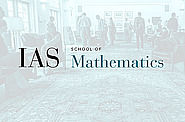2022-2023 Seminars
May
09
2023
Computer Science/Discrete Mathematics Seminar II
Using Expanders for Fast Graph Algorithms
Thatchaphol Saranurak
10:30am|Simonyi Hall 101 and Remote Access
May
08
2023
Computer Science/Discrete Mathematics Seminar I
Graph Vertex Expansion
Theo McKenzie
11:15am|Simonyi 101 and Remote Access
May
02
2023
Computer Science/Discrete Mathematics Seminar II
Fitting Various Metrics with Minimum Disagreements
Euiwoong Lee
10:30am|Simonyi Hall 101 and Remote Access
May
01
2023
Computer Science/Discrete Mathematics Seminar I
A Constant Lower Bound for Frankl's Union-Closed Sets Conjecture
Justin Gilmer
11:15am|Simonyi 101 and Remote Access
Apr
25
2023
Computer Science/Discrete Mathematics Seminar II
A Unified Approach to Discrepancy Minimization
Nikhil Bansal
10:30am|Simonyi Hall 101 and Remote Access
Apr
24
2023
Computer Science/Discrete Mathematics Seminar I
Approximating Iterated Multiplication of Stochastic Matrices in Small Space
Dean Doron
11:15am|Simonyi 101 and Remote Access
Apr
18
2023
Computer Science/Discrete Mathematics Seminar II
Existence of Subspace Designs
Ashwin Sah
10:30am|Simonyi Hall 101 and Remote Access
Apr
17
2023
Computer Science/Discrete Mathematics Seminar I
Unit and Distinct Distances in Typical Norms
11:15am|Simonyi 101 and Remote Access
Apr
11
2023
Computer Science/Discrete Mathematics Seminar II
Updates on the Lipschitz Extension Problem
10:30am|Simonyi Hall 101 and Remote Access
Apr
10
2023
Computer Science/Discrete Mathematics Seminar I
Quantum Error Correction, Systolic Geometry, and Probabilistic Embeddings
Elia Portnoy
11:15am|Simonyi 101 and Remote Access
